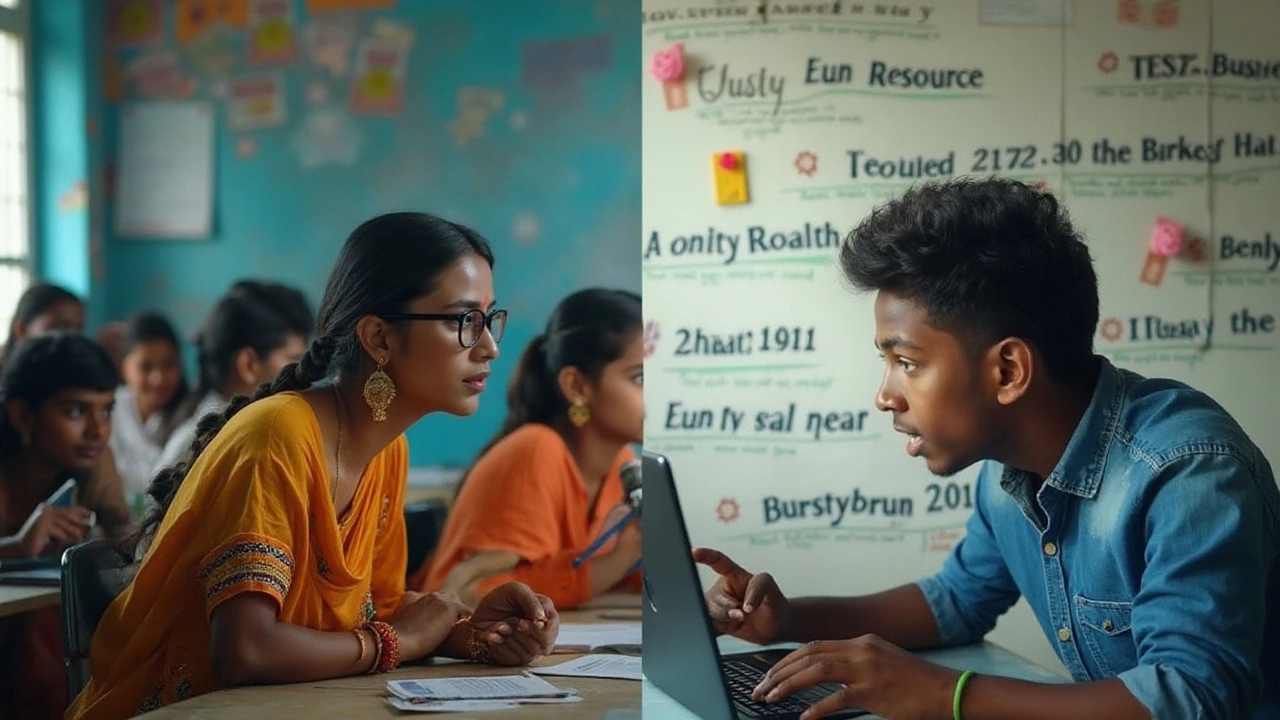
In the evolving landscape of education, both classroom learning and eLearning have carved unique niches. As we stand at the crossroads of tradition and innovation, it's vital to delve into what really sets these two apart. Each method brings along a set of advantages that cater to different learning styles and needs. Whether you're a student considering your options or an educator seeking to expand your teaching methods, understanding these differences can help you make informed choices.
Classroom learning has been the cornerstone of education for centuries, offering interactive and social experiences. In contrast, eLearning has surged in popularity, providing unparalleled flexibility and accessibility with just a click. The rise of digital education has opened doors to new learning opportunities, transcending geographic and time barriers and giving students control over their educational journeys.
Join us as we explore the intricacies of these two learning environments, examining their strengths, weaknesses, and the role of technology in shaping the education of tomorrow. Whether you're drawn to the structured environment of a classroom or the dynamic world of online courses, this article will guide you in determining which path aligns best with your educational and personal goals.
- Traditional Classroom Learning: An Overview
- The Digital Shift: Exploring eLearning
- Comparative Analysis: Strengths and Weaknesses
- The Role of Technology in Learning
- Choosing the Right Approach for You
Traditional Classroom Learning: An Overview
Traditional classroom learning has been the bedrock of educational systems around the globe. It's an environment familiar to most of us—a teacher leading a group of students in a designated space equipped with chalkboards, desks, and books. This setting isn’t just about the transmission of knowledge but is also a hub of social interaction and personal development. Students engage with both teachers and peers, fostering a collaborative spirit that can be pivotal in shaping their social skills. The dynamics of a classroom allow for real-time feedback, so students can instantly get answers to their questions and actively participate in discussions.
In the traditional classroom, the teacher often acts as the primary source of knowledge, guiding students through a structured curriculum. This method emphasizes discipline and routine, which many argue builds a solid foundation for learning. Regular schedules, fixed locations, and face-to-face communication help cultivate habits and focus. A sense of camaraderie often develops among classmates, creating an environment that encourages teamwork and peer learning. One key benefit is the opportunity for hands-on activities and experiments, particularly in subjects like science, where practical demonstration enriches understanding.
Another crucial aspect is the clear hierarchy and systematic delivery of content, which can help keep students organized and on track. Teachers can assess the progress of their students through various means—quizzes, assignments, class participation, and exams. This approach to learning lends itself well to students who thrive on structure and immediate, interactive feedback. Many educators believe that the fixed nature of classroom learning can reduce distractions and keep students more focused on tasks. As the education expert John Dewey once said, "Education is not preparation for life; education is life itself."
While traditional classrooms have their strengths, they are often characterized by uniformity, which might not cater to every student’s learning style. Learning is predominantly linear, with curricula set at a specific pace that may not suit those who grasp concepts faster or slower than the average. Despite these limitations, the interpersonal aspect, combined with the structured learning environment, continues to make traditional classroom education a valuable and irreplaceable component of education today. It remains a cornerstone of cultivating disciplined learning habits and critical thinking skills.
The Digital Shift: Exploring eLearning
The rise of eLearning marks a significant transformation in the way we conceive education. No longer confined within the four walls of a classroom, learning has transcended physical spaces, moving into a digital realm that's as vast as the internet itself. This shift to online education has been driven by the rapid advancements in technology, allowing learners to access courses and materials from anywhere in the world, often at their own pace. Whether it's through Massive Open Online Courses (MOOCs) or customized learning platforms, education technology has made knowledge more accessible than ever before. Not only does eLearning cater to students across all demographics, but it also provides self-directed learning opportunities that traditional setups sometimes lack.
One of the major benefits of eLearning is its inherent flexibility. Unlike traditional classroom learning, which mandates a rigid schedule, eLearning allows students to balance their studies with personal and professional commitments. This flexibility is supported by an array of educational resources online, such as video lectures, interactive simulations, and forums for discussion, making it an inclusive option for continued education. A recent survey by the National Center for Education Statistics revealed that over 6 million students in the U.S. are currently enrolled in distance education courses, highlighting the growing trend towards digital learning environments.
In embracing the digital shift, it's crucial to acknowledge the interactive elements that can enhance the online learning experience. Tools like gamification, virtual reality, and augmented reality are increasingly being integrated into eLearning platforms to make learning more engaging and effective. These technologies not only keep learners interested but also facilitate a practical understanding of complex subjects. A report by the eLearning Industry suggests that the use of gamification can increase learner retention rates by up to 60%, underscoring its potential impact on educational outcomes.
Despite its many benefits, eLearning is not without its challenges. Issues like digital literacy, internet accessibility, and the need for self-discipline can affect how successful learners are in this environment. To counter these challenges, many institutions are investing in resources to support students, such as training programs for digital tools and initiatives to provide better internet access in underserved areas. There's also a focus on developing soft skills like time management and critical thinking, which are essential for thriving in any learning context.
Ultimately, the digital shift in education is not just about replicating the classroom experience online. It's about harnessing the power of technology to create a more personalized, accessible, and flexible educational journey. As eLearning continues to evolve, it holds the promise of reaching more students than ever before, breaking down barriers to education, and setting a new standard for what learning can be. As Sir Ken Robinson once eloquently stated,
"Education doesn't need to be reformed—it needs to be transformed. The key to this transformation is not to standardize education, but to personalize it, to build achievement on discovering the individual talents of each child."

Comparative Analysis: Strengths and Weaknesses
Diving into the realms of classroom learning and eLearning, one quickly discovers a tapestry of unique benefits and inevitable drawbacks inherent in each approach. Traditional classroom learning often resonates with those appreciating a structured rhythm, brought to life by tangible interactions and a dynamic environment. Here, teachers can gauge student reactions in real-time, adapt teaching methods instantaneously, and foster an engaging, lively discussion that stimulates intellectual curiosity. Students often thrive on the energy of peers, with face-to-face collaboration cultivating deeper understanding and a sense of camaraderie that can greatly enhance the learning experience.
On the other hand, the advent of technology has propelled eLearning into the education spotlight, reshaping how knowledge is imparted and digested. One major strength of this digital revolution is its flexibility. Learners can tailor their educational journey to suit personal schedules, environments, and paces, making education more inclusive and accommodating. Remote learning platforms offer a plethora of resources at one’s fingertips, from interactive modules to virtual simulations that enrich understanding in ways physical classrooms sometimes can't. Moreover, learners aren't confined by geographical or institutional boundaries, expanding their horizons and access to global educational content.
However, it's crucial to acknowledge the potential downsides inherent in both modalities. Classroom learning, while interactive, can occasionally fall prey to the constraints of time, space, and pace, not always aligning with the diverse needs and circumstances of every student. Some may find it challenging to balance a rigid schedule alongside other commitments or personal learning paces. Meanwhile, eLearning carries its share of challenges, notably the requirement of intrinsic motivation and discipline. Without the consistent structure that classrooms provide, students might struggle with time management. The absence of physical presence and social interactions can also make some learners feel isolated, potentially impacting engagement and mental well-being.
Expert Opinions and Insights
"While online learning represents a frontier full of potential, the core essence of education—connection and collaboration—should not be overshadowed by technological advancements. It’s our task to blend creativity with technology responsibly," suggests Dr. Emily Greene, an educational psychologist.
To truly appreciate the merits and drawbacks of each method, one must delve into practical experiences and personalized needs. A hybrid model, utilizing the strengths of both modalities, might emerge as an innovative path forward. As we continue to study and adapt these systems, the focus should remain on enhancing educational experiences, making them more inclusive and effective for all. Harnessing the strengths and acknowledging the weaknesses of each method can lead to a more holistic approach to learning, where innovation and tradition coexist in harmony.
The Role of Technology in Learning
Technology has become a cornerstone in modern education, revolutionizing both classroom learning and eLearning by introducing innovative tools that enhance the overall educational experience. In traditional classrooms, technology has paved the way for interactive smart boards, digital projectors, and tablets, which have drastically changed the teaching dynamic. These tools facilitate a more engaging and interactive learning environment, enabling teachers to present complex concepts through visual aids and simulations. Meanwhile, students benefit from an enriched understanding through direct engagement with educational media.
Rising from the need for more accessible education, eLearning arguably showcases the most significant impact of technology on education. It leverages platforms that deliver a multitude of courses and resources directly to a student’s device. This setup defies geographical constraints and time zones, offering individuals the ability to learn at their own pace—a major advantage for those juggling education with work or other responsibilities. The use of Learning Management Systems (LMS), such as Moodle or Blackboard, supports educators by streamlining course documentation, tracking student progress, and fostering communication, thus optimizing both teaching and learning processes.
Another intriguing aspect of technology in learning is the growth of Artificial Intelligence (AI) in educational technologies. AI can personalize learning experiences by adapting content to fit individual learning speeds and styles. This personalization helps bridge the gap between varied learner abilities and preferences, potentially mitigating frustrations often encountered in one-size-fits-all teaching approaches. A recent report by eLearning Industry highlighted that AI could increase student performance by up to 30% when integrated effectively. This statistic underlines the transformative potential of AI, emphasizing the importance of its thoughtful implementation in educational strategies.
Moreover, technology fosters global collaboration and learning through digital classrooms and forums. Students from around the world can coalesce, sharing ideas and cultural perspectives that enrich their educational journey beyond textbooks. Programs like Skype in the Classroom and virtual exchange platforms are perfect examples of how technology transcends conventional barriers, bringing diverse experiences directly to students and making them more adaptable in a globalized world. As Sir Ken Robinson famously noted, "We are living in amazing times. The technology that surrounds us today would be magic to previous generations." No longer confined to physical spaces, education now has the power to connect and inspire like never before.

Choosing the Right Approach for You
When deciding between classroom learning and eLearning, it's important to consider a variety of factors that can influence your educational experience. Your personal learning style plays a crucial role in this decision. Some people thrive in an interactive, face-to-face environment where they can engage directly with teachers and peers in a traditional setting. This immediate feedback and personal interaction help forge deeper connections to the material being studied. On the other hand, eLearning environments cater to those who value flexibility and independence in their studies. This mode allows individuals to learn at their own pace, accessing resources that suit their personal schedule and lifestyle.
Consider also the subject matter of your study. Certain subjects may inherently benefit from one method over the other. For instance, hands-on disciplines such as laboratory sciences or physical education may be better suited to a classroom learning environment where tactile and direct visual interaction is essential. Conversely, subjects that are fundamentally theory-based, like some humanities or business courses, often transition smoothly into eLearning platforms, where a wealth of resources can be easily accessed online. Either way, understanding your subject requirements allows you to make a well-informed decision on the most suitable learning approach.
Financial and time considerations are equally significant. Traditional classroom learning generally implies a fixed schedule which can conflict with existing work or family commitments. It might also involve higher expenses related to commuting or living costs. Alternatively, eLearning can offer cost-effective solutions, especially in terms of reduced travel expenses and flexible scheduling, which can accommodate full-time work or caregiving responsibilities. Yet, it's worthwhile to remember that some online courses may require technology investments such as a reliable computer and internet connection.
"The beautiful thing about learning is that no one can take it away from you." — B.B. King
The technological aspect shouldn't be ignored, as proficiency with digital tools is necessary for eLearning. Comfort with online learning environments, ability to troubleshoot minor technical issues, and motivation to solve digital challenges independently are vital skills. Should you feel less confident in your digital skills, additional training or support resources may be necessary. Conversely, if you're already immersed in digital culture, eLearning may come naturally.
Lastly, think about your future goals. Whether you're looking at academic improvement or professional advancement, aligning your learning method with future objectives is crucial. Many industries today look favorably upon candidates who show initiative through self-paced online courses, demonstrating not only their learning but the ability to self-manage. However, fields that value collaboration or teamwork may still prioritize traditional degrees and classroom-based credentials.
| Aspect | Classroom Learning | eLearning |
|---|---|---|
| Interaction | High, face-to-face | Moderate, virtual |
| Flexibility | Low | High |
| Cost | Often higher | Generally lower |
| Technology Need | Minimal | High |
